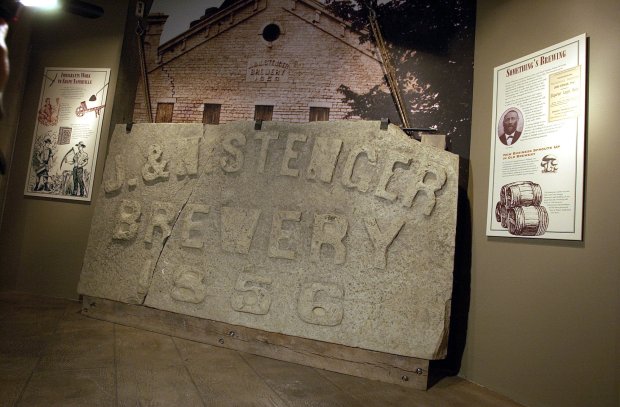Every week we publish a historic photo highlighting a story from Naperville’s past from the history archives of Naper Settlement.
These days, you can find all sorts of craft brews at local liquor stores but back in the 1800s, you could buy beer brewed right here in Naperville.
Over the years, several breweries were based in town, producing libations to quench the thirst of a growing population.
Jacob Englefriedt operated what is considered to be Naperville’s first brewery at the northwest corner of Webster Street and Jackson Avenue from 1842 to 1846. He relocated to another site on Franklin Avenue between Webster and Main Street and then sold the operation to Peter Stenger in 1849.
Englefriedt’s first location did not go unused. It was soon occupied by the Egermann Brewery.
Xavier Egermann — billed as a “brewer of lager beer” — ran his brewery there from 1846 to 1869. He sold it to Joseph Egermann, who operated it from 1869 to 1872, before it changed hands again and was purchased by George Von Hollen and Charles Kluetsch of Chicago. Their American Breweries was in business in 1874 and 1875.
Just down the street, Schamberger Brewery opened at the northwest corner of Eagle Street and Jackson Avenue in 1896. Joseph Schamberger’s Weiss ale that was described as “a White Beer that was very intoxicating.”
Beer bottles from the Schamberger Brewery were found when a brewery tunnels linking the Egermann first and second breweries, hand-dug and lined with limestone, collapsed during the construction of Nichols Library. Bottles also turned up during construction of the Rubin Community Center at 305 Jackson Ave.
Stenger Brewery had a long history in Naperville, serving up beer for nearly a half-century, from 1849 to the mid-1890s.
Peter Stenger Sr. ran the business on Franklin Avenue from 1849 to 1851, and was succeeded by his sons John and Nicholas Stenger, who were in charge from 1851 to 1864. After Nicholas’ death in 1864, John continued on his own.
When the original operation burned down in 1854, a series of stone buildings were constructed on eight acres at the northwest corner of Eagle and Jackson. It was adjacent to John Stenger’s 84-acre farm, which extended from Franklin Street to Ogden Avenue.
A brewhouse was added to the site in 1854, followed two years later by a malt house. Naper Settlement has the stone from this building on display at part of its Building Naperville exhibit.
The 1886 Holland’s Business Directory spoke highly of the Stenger Brewery:
“The above brewery is one of the oldest in the state and has produced some of the finest beverages of their kind, large quantities of which have been disposed of and consumed in this community as well as shipped to distant points,” the directory said.
“Some time ago Mr. (John) Stenger began experiments in order to improve, if possible, this fine quality, and in so doing sunk many thousands of dollars. During the past few years, however, he has returned to his old and original method of manufacture, and now as formerly, produces beer which is securing fresh customers weekly,” the directory said.
Stenger expanded his footprint, and began selling beer from Elgin to Ottawa. However, competition from newer, more efficient breweries in Chicago began cutting into his profit margin and he decided to get out of the business in 1892.

(John Stenger also served on the Naperville Village Board and the Naperville School Board, founded a cheese factory on the site of the burned brewery and helped build Sts. Peter and Paul Catholic church in Naperville. The seventh generation of the family still lives in Naperville.)
The brewery was sold to Henn & Gabler, a Chicago company, and was recast as the Chicago and Naperville Brewery Co. It operated as a distributor until 1896, and was then absorbed into the United Breweries Co.
Interestingly, Naperville’s brewing operations gave way to mushrooms in the early 20th century.
In 1917, A.V. Jackson started cultivating mushrooms in the former Stenger building, doing business as the Illinois Mushroom Co. It was one of six subsidiaries of Dawn Fresh mushrooms.
The former brewery afforded the perfect place to grow funghi, which do best in dark rooms with closely controlled temperature and humidity. Horse manure was trucked in from the Maywood Park race track, taken first to Montgomery to be cured before being brought to Naperville.
Seventy carloads were required to fill one bed. When the beds were set, the room was closed and steam blown at a temperature of 150 degrees to kill insects and ensure disease-free mushrooms.
Chunks of mushroom spawn were then buried in the beds 10 inches apart. It took three weeks for the spawn to produce fruit using a growing temperature of 58 to 60 degrees. Five to six crops could be grown each season.
Mushrooms weren’t grown during the summer because temperatures made it too hot for planting.
Half the mushrooms produced in Naperville went to Jewel Foods stores. Half-pound boxes were sold at a commission market in Chicago.
Campbell’s Soup company bought the larger produce, and leftovers went to the Dawn Fresh cannery in Aurora.
The business lasted until 1953. Its buildings were razed in 1956, and the site later became home to Naperville central office of the Illinois Bell Telephone Co.
Andrea Field is the curator of history at Naper Settlement, www.NaperSettlement.org. Steve Metsch is a freelance reporter for the Naperville Sun.




